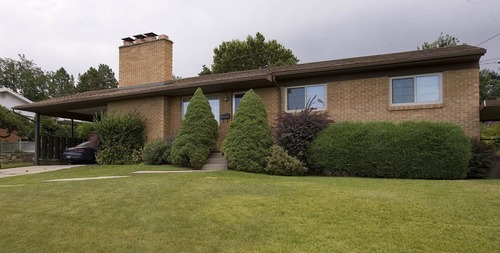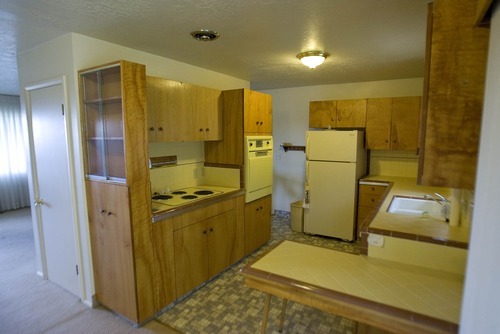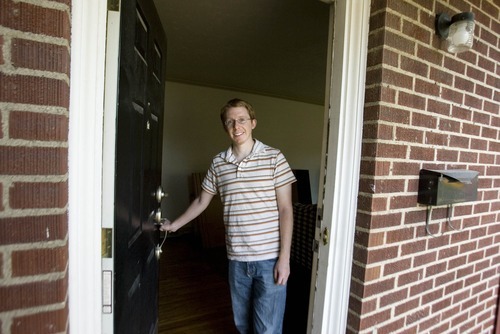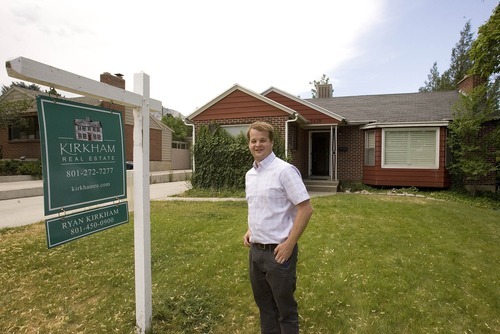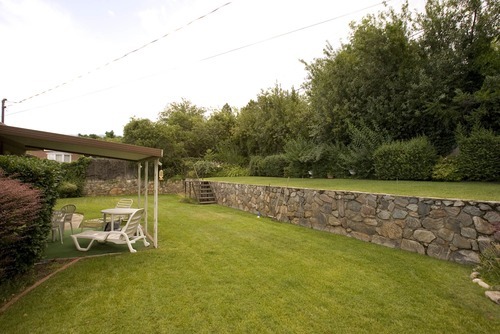This is an archived article that was published on sltrib.com in 2012, and information in the article may be outdated. It is provided only for personal research purposes and may not be reprinted.
At the height of the real estate market in 2007, a 4,300-square-foot two-story home in the Daybreak subdivision could have fetched as much as $575,000.
So it's easy to see why, at a list price today of only $299,900, the seller has been inundated with offers — so many, in fact, that the listing agent decided to stop receiving bids after getting no fewer than 18 of them.
Welcome to the Wasatch Front's housing recovery of 2012.
With 30-year mortgage rates below 4 percent and signs that prices have stabilized, buyers are back. And with them comes something the residential market here hasn't seen in awhile — multiple offers, many above asking price.
"If a good home comes on the market at a good price, everyone is all over it, right away," said Adam Kirkham, associate broker and co-owner of Kirkham Real Estate in Salt Lake City.
Although many homeowners are relieved to see some positive signs after nearly five years of falling home sales and prices, Kirkham said today's market isn't an easy one — for real estate agents or for buyers.
"There's definitely a learning curve," he said. "A lot of people still think it's a buyer's market."
—
Market shift • In some ways, it still is. Although home sales and prices have increased in recent months, buyers, worried about further price decreases, are still cautious and are trying to get a great deal. Bidding wars do happen, but they fizzle quickly. And homes that are priced above current values can go begging for buyers.
But in most other ways, it's definitely a seller's market. Inventory is low in most areas and price ranges, and buyers generally outnumber available properties. There also is an urgency among many buyers given the fact that mortgage rates have slipped into an almost laughable low and, like prices, are almost certain to increase. "If rates were at 5, 6 percent, I don't think we'd be seeing such an urgency among buyers," Kirkham said.
The bottom line is that homes that are priced right and in good condition don't remain on the market long.
"A lot of people with money who have been waiting to buy a home have decided that it's a great time to buy," said Donna Pozzuoli, president of the Salt Lake Board of Realtors.
That doesn't mean buying a home right now is a slam dunk by any means. If the shaky economic recovery stumbles, home values could slip even more. And even among economists who don't expect that to happen, no one is expecting anywhere near the heady double-digit increases of the early to mid-2000s. In fact, most housing forecasts predict an annual home-price increase in the coming years of 2-3 percent at best.
Still, lower prices and super-low mortgage rates can translate into a monthly payment that is similar or even lower than what some pay in rent. And that's a powerful incentive for buyers such as Ryan Welch of Salt Lake City. After years of putting off buying a home, he and his wife decided several months ago to start looking for their first. He said he was surprised at how quickly homes were snapped up by other buyers.
"We've been wanting to buy for six years. We were just waiting for the right time."
Like many buyers, Welch wonders if he waited a bit too long to act. "Once you look at the inventory of homes that are available, you know it's not going to be easy," he said.
When a home in the Canyon Rim area of Salt Lake City came on the market recently for $239,900, the couple rushed out to look at it and immediately made an offer of $229,000, even though it needs some work. Three offers ultimately were made on the home within the first week; the bank accepted theirs.
The home is being sold by a bank as a short sale, which means the seller owes more than the property is worth. This adds more complexity to a deal because the bank has to approve the final contract.
On the upside, the home is in a good neighborhood and has an updated kitchen. Even better, Welch and his wife nabbed a 3.75 percent mortgage rate.
—
Seen in the numbers • The dynamics of the rebound, which first became apparent early this year, can now be seen in home-sale statistics.
In May, the most recent month for which data are available, sales of previously owned homes and condominiums in Salt Lake County rose by 15 percent, to 1,229 units, compared with May 2011, according to the Salt Lake Board of Realtors. In the first five months of 2012, sales jumped 20 percent over last year.
The home-sale increase has paved the way for modest price increases. In May, the median selling price rose 7 percent, to $199,950, compared with $187,000 last year. Although prices are still below the peak median of $242,000 in June 2007, this type of appreciation has been unheard of for five years.
In fact, prices increased on a year-over-year basis in both April and May, the first back-to-back monthly jumps since the downturn began.
In terms of inventory, about 4,700 homes in Salt Lake County are listed for sale but not yet under contract. That's a 15-year low. Inventory levels peaked in 2008 at 8,200 active listings, according to data from the Realtor group.
The downturn began in 2007 when the nation's subprime lending crisis led to a crackdown on loose lending standards in which almost anyone could qualify for a home loan. The accompanying housing bust made it tougher to get a home loan or to refinance.
—
Uncertain market • Financing is still an issue — many buyers still can't qualify for a home loan and those who do often can't borrow all they had hoped. And many Utahns still are struggling with unemployment and underemployment.
But thanks to all the corporate expansions along the Wasatch Front, there are more people with the jobs and the incomes needed to buy a home.
Interest among potential buyers led a homeowner in Bountiful to recently raise the asking price to $195,000 from $188,000. The 2,200-square-foot home eventually went under contract even higher — at $201,000.
Although the deals — both in terms of home prices and mortgage rates — can be the best in years, buyers face another big obstacle aside from low inventory levels.
Much of the market is made up of distressed properties in the form of either foreclosures or short sales, which can lead to complex and time-consuming home purchases. Distressed-property sales often can take longer — sometimes much longer — than a traditional purchase.
Yet they can be difficult to avoid. In Salt Lake County, there are about 1,300 homes listed as short sales, which represents about 20 percent of all the 6,700 active and under-contract listings. Add in foreclosures, and the share of distressed properties on the market account for 30 percent to 40 percent of all listings.
—
Demand and supply • That said, the deals offered by a bank trying to unload unwanted real estate often can't be beat.
The bad news for bargain seekers is that the flood of distressed properties has slowed to more of a dribble. Although last year there was some worry that another big wave of foreclosures locally in 2012 could hurt the recovering housing market, most real estate agents along the Wasatch Front are now doubtful there will be another wave here. And even if there is, it would be welcomed as a way to ease the inventory crunch.
"Another wave of foreclosures hitting the market wouldn't actually be so bad right now," says the Salt Lake Board of Realtors' Pozzuoli.
Over time, low inventory levels and higher demand eventually could lead to sustained home-price increases. That's because buyers competing against each other increasingly make above-asking-price offers.
And although that reduces affordability, it does ease another problem — the high share of homeowners who are underwater, or who owe more than their homes are worth. An estimated one-quarter of homeowners in Utah are either underwater or near that point, which makes it difficult to sell their home without approval from a bank. Homeowners in that situation are either stuck paying on homes that they can't sell or forced to walk away from their loan obligations.
In South Jordan, at the property in the Daybreak development, the sellers did just that. The vacated home is being sold by a bank via short sale, which is reviewing the 18 offers. With more than one dozen offers, the Multiple-Listing Service entry on the home warns agents not to submit any other offers or show the home to prospective buyers.
Buyers vying the for the property have bid up the asking price of the home, listed at $299,900, to $350,000.
The highest offer often is accepted but not always. Cash buyers have an advantage, as in some cases do those with conventional loans instead of lower-down payment loans insured by the Federal Housing Administration.
"A good, clean house at a great price — only $69 per square foot — it's too good to pass up," Kirkham said. "Even at $350,000, it's still a great deal."
lesley@sltrib.com Twitter: @cheapchick Facebook: Facebook.com/OneCheapChick —
Tips for buyers and sellers
Donna Pozzuoli, president of the Lake Board of Realtors, has some time-tested tips for those buying or selling a home:
For sellers:
Clean it up and de-clutter • A clean and tidy home makes all the difference. "Get rid of the junk — get a storage shed if you need to," she said.
Make small improvements • "Small, inexpensive things can make a big difference," Pozzuoli says. "Things like paint and caulk are fairly inexpensive but can have a big impact."
Be willing to make concessions • The feds have cut down on what sellers can do for buyers in recent years. But sellers still can offer a home warranty or pay some or all of the buyer's closing costs.
For buyers:
Make an offer quickly • "If you find a home at a good price and in good condition, you need to make an offer quickly," she said.
Sell the home you are in • Offers contingent on the sale of your own home likely will be thrown out in this type of market.
Get preapproved • Don't even think about making an offer without financing. Sellers aren't interested.


